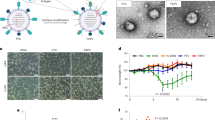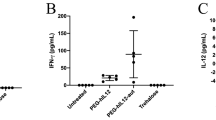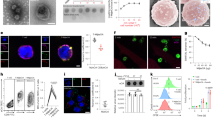Abstract
Targeted therapies directed to tumor-associated antigens are being investigated for the treatment of cancer. However, there are few suitable animal models for testing the ability to target these tumor markers. Therefore, we have exploited mice transgenic for the human coxsackie and adenovirus receptor (hCAR) to establish a new model for transient expression of human tumor-associated antigens in the pulmonary vasculature. Systemic administration of Ad in hCAR mice resulted in an increase in transgene expression in the lungs compared to wild-type mice, as determined using a luciferase reporter gene. To reduce transgene expression in the liver, the predominant organ of ectopic Ad localization and transgene expression following systemic administration, we utilized the endothelial-specific flt-1 promoter, which resulted in a further increased lung-to-liver ratio of luciferase expression. Administration of an adenoviral vector encoding the tumor-associated antigen carcinoembryonic antigen (CEA) under transcriptional control of the flt-1 promoter resulted in selective expression of this antigen in the pulmonary vasculature of hCAR mice. Feasibility of targeting to expressed CEA was subsequently demonstrated using adenoviral vectors preincubated with a bifunctional adapter molecule recognizing this tumor-associated antigen, thus demonstrating utility of this transient transgenic animal model.
This is a preview of subscription content, access via your institution
Access options
Subscribe to this journal
Receive 12 print issues and online access
$259.00 per year
only $21.58 per issue
Buy this article
- Purchase on Springer Link
- Instant access to full article PDF
Prices may be subject to local taxes which are calculated during checkout






Similar content being viewed by others
References
Boerman OC, van Schaijk FG, Oyen WJ, Corstens FH . Pretargeted radioimmunotherapy of cancer: progress step by step. J Nucl Med 2003; 44: 400–411.
Wels W et al. Recombinant immunotoxins and retargeted killer cells: employing engineered antibody fragments for tumor-specific targeting of cytotoxic effectors. Cancer Immunol Immunother 2004; 53: 217–226.
Glasgow JN, Bauerschmitz GJ, Curiel DT, Hemminki A . Transductional and transcriptional targeting of adenovirus for clinical applications. Curr Gene Ther 2004; 4: 1–14.
Kruyt FA, Curiel DT . Toward a new generation of conditionally replicating adenoviruses: pairing tumor selectivity with maximal oncolysis. Hum Gene Ther 2002; 13: 485–495.
Hammarstrom S . The carcinoembryonic antigen (CEA) family: structures, suggested functions and expression in normal and malignant tissues. Semin Cancer Biol 1999; 9: 67–81.
Slamon DJ et al. Human breast cancer: correlation of relapse and survival with amplification of the HER-2/neu oncogene. Science 1987; 235: 177–182.
Khalil MY, Grandis JR, Shin DM . Targeting epidermal growth factor receptor: novel therapeutics in the management of cancer. Expert Rev Anticancer Ther 2003; 3: 367–380.
Muders M et al. Studies on the immunogenicity of hCEA in a transgenic mouse model. Int J Colorectal Dis 2003; 18: 153–159.
McLaughlin PM et al. The epithelial glycoprotein 2 (EGP-2) promoter-driven epithelial-specific expression of EGP-2 in transgenic mice: a new model to study carcinoma-directed immunotherapy. Cancer Res 2001; 61: 4105–4111.
McClarrinon M et al. In vivo studies of gene expression via transient transgenesis using lipid-DNA delivery. DNA Cell Biol 1999; 18: 533–547.
Shayakhmetov DM, Li ZY, Ni S, Lieber A . Targeting of adenovirus vectors to tumor cells does not enable efficient transduction of breast cancer metastases. Cancer Res 2002; 62: 1063–1068.
Li ZY et al. Xenograft models for liver metastasis: relationship between tumor morphology and adenovirus vector transduction. Mol Ther 2004; 9: 650–657.
Ando K et al. CTL access to tissue antigen is restricted in vivo. J Immunol 1994; 153: 482–488.
Tallone T et al. A mouse model for adenovirus gene delivery. Proc Natl Acad Sci USA 2001; 98: 7910–7915.
Reynolds PN et al. Combined transductional and transcriptional targeting improves the specificity of transgene expression in vivo. Nat Biotechnol 2001; 19: 838–842.
Le LP et al. Fluorescently labeled adenovirus with pIX-EGFP for vector detection. Mol Imaging 2004; 3: 105–116.
Dmitriev I et al. An adenovirus vector with genetically modified fibers demonstrates expanded tropism via utilization of a coxsackievirus and adenovirus receptor-independent cell entry mechanism. J Virol 1998; 72: 9706–9713.
Belousova N, Krendelchtchikova V, Curiel DT, Krasnykh V . Modulation of adenovirus vector tropism via incorporation of polypeptide ligands into the fiber protein. J Virol 2002; 76: 8621–8631.
Wu H et al. Construction and characterization of adenovirus serotype 5 packaged by serotype 3 hexon. J Virol 2002; 76: 12775–12782.
Dmitriev IP, Kashentseva EA, Curiel DT . Engineering of adenovirus vectors containing heterologous peptide sequences in the C terminus of capsid protein IX. J Virol 2002; 76: 6893–6899.
Schraa AJ et al. Targeting of RGD-modified proteins to tumor vasculature: a pharmacokinetic and cellular distribution study. Int J Cancer 2002; 102: 469–475.
Satchi-Fainaro R et al. Targeting angiogenesis with a conjugate of HPMA copolymer and TNP-470. Nat Med 2004; 10: 255–261.
Greenberger S et al. Transcription-controlled gene therapy against tumor angiogenesis. J Clin Invest 2004; 113: 1017–1024.
Braciak TA et al. Construction of recombinant human type 5 adenoviruses expressing rodent IL-6 genes. An approach to investigate in vivo cytokine function. J Immunol 1993; 151: 5145–5153.
Miller G et al. Natural killer cell depletion confounds the antitumor mechanism of endogenous IL-12 overexpression. Int J Cancer 2004; 110: 395–402.
Deng JC, Tateda K, Zeng X, Standiford TJ . Transient transgenic expression of gamma interferon promotes Legionella pneumophila clearance in immunocompetent hosts. Infect Immun 2001; 69: 6382–6390.
He TC et al. A simplified system for generating recombinant adenoviruses. Proc Natl Acad Sci USA 1998; 95: 2509–2514.
Maizel Jr JV, White DO, Scharff MD . The polypeptides of adenovirus. I. Evidence for multiple protein components in the virion and a comparison of types 2, 7A, and 12. Virology 1968; 36: 115–125.
Nicklin SA et al. Analysis of cell-specific promoters for viral gene therapy targeted at the vascular endothelium. Hypertension 2001; 38: 65–70.
Conry RM et al. Immune response to a carcinoembryonic antigen polynucleotide vaccine. Cancer Res 1994; 54: 1164–1168.
Raben D et al. Enhancement of radiolabeled antibody binding and tumor localization through adenoviral transduction of the human carcinoembryonic antigen gene. Gene Therapy 1996; 3: 567–580.
Zhu ZB et al. Transport across a polarized monolayer of Caco-2 cells by transferrin receptor-mediated adenovirus transcytosis. Virology 2004; 325: 116–128.
Reynolds PN . Delivery of DNA to pulmonary endothelium using adenoviral vectors. In: Heiser WC (ed) Gene Delivery to Mammalian Cells: Methods and Protocols. Humana Press: Totowa, NJ, USA, 2002, pp 69–90.
Acknowledgements
We thank Dr S Petterson for his kind gift of the transgenic hCAR mice, and the transgenic facility at the University of Alabama at Birmingham for maintaining and screening the transgenic mice. We also thank CR Stockard for his technical assistance with the immunohistochemistry for CEA. This work was supported by the following grants: 1 P01 HL076540, P01 HL075640-01, RO1 HL67962, RO1 AG021875, W81XWH-04-1-0025, MDA3590, and NHMRC (Australia). MA Preuss and MJ Passineau are further supported by T32 HL07553. WE Grizzle is supported by the Breast and Ovarian SPORES at UAB (CA 89019-04 and CA-83591-05, respectively).
Author information
Authors and Affiliations
Rights and permissions
About this article
Cite this article
Everts, M., Kim-Park, SA., Preuss, M. et al. Selective induction of tumor-associated antigens in murine pulmonary vasculature using double-targeted adenoviral vectors. Gene Ther 12, 1042–1048 (2005). https://doi.org/10.1038/sj.gt.3302491
Received:
Accepted:
Published:
Issue Date:
DOI: https://doi.org/10.1038/sj.gt.3302491
Keywords
This article is cited by
-
A myeloid cell-binding adenovirus efficiently targets gene transfer to the lung and escapes liver tropism
Gene Therapy (2013)
-
Targeting of mesenchymal stem cells to ovarian tumors via an artificial receptor
Journal of Ovarian Research (2010)
-
Directing adenovirus across the blood–brain barrier via melanotransferrin (P97) transcytosis pathway in an in vitro model
Gene Therapy (2007)
-
Targeting EGFR with metabolically biotinylated fiber-mosaic adenovirus
Gene Therapy (2007)
-
Engineering targeted viral vectors for gene therapy
Nature Reviews Genetics (2007)



